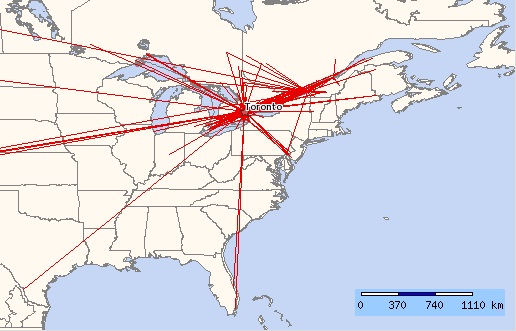Invasive forest pests can enter Canada and new areas through a number of pathways, both natural and human-influenced. Increased urbanization could aid the spread of invasive species, as people move from one area to another and through movement of goods and materials into larger areas. Expansion of transportation networks could also act as new and additional pathways for the spread of invasive pests, as they can stow away on cars or in materials that are moved along new roads and into new areas. Some examples of these pathways are:
Natural dispersal from neighbouring locations:
Flying insects, such as Emerald Ash Borer, can spread into new areas by flying into adjacent areas to those already affected.
Spores of invasive diseases or fungus can be spread when insects or animals pick up these spores on their fur or bodies and transfer them to another spot.
Insects or spores of invasive diseases could be spread into adjacent areas by being carried in gusts of winds.
Invasive horticultural or ornamental plants that have been used in urban gardens can spread into adjacent natural areas.
Artificial spread influenced by humans:
Terrestrial Movement
- Travelling on packaging materials (e.g. wooden crates) being imported into the country.
- Stowing away in luggage when travelers return home from other countries.
- The movement of firewood or other forest materials.
- Transport of topsoil from one area to another.
- Transport of raw wood and lumber.
- Transport of nursery stock.
- Transfer of spores of invasive species from one area to another when people do not properly clean hiking boots or recreational equipment before moving to a new location.
Aquatic Movement
Pathway Analysis
High-risk reverse pathway analysis for Toronto, Ontario. The vectors depict the most likely pathways of entry of invasive species introductions in Toronto (generated using the FIAS Pathway Explorer).

Due to urbanization and international trade, the human-influenced spread of invasive species across borders has been increasing in recent years. It is important for officials to take a proactive approach to stop the spread of invasive species from entering the country, both nationally and internationally. One of the best methods to prevent the arrival of an invasive species is to identify the potential pathways it could follow to arrive.
The Forest Invasive Alien Species (FIAS) team at Natural Resources Canada has developed an on-line ‘Pathway Explorer’ to generate instant displays of high and low-risk pathways of spread, specific to cities across Canada. This tool is valuable to conduct reverse-pathway analyses (where will an invasive species come from?), and forward-pathway analyses (where will the invasive species spread to next?) to predict the spread patterns of invasive species.
Programs like this allow experts to anticipate where and when an invasive species might first invade, and take a proactive targeted approach at prevention, surveillance, and management.
